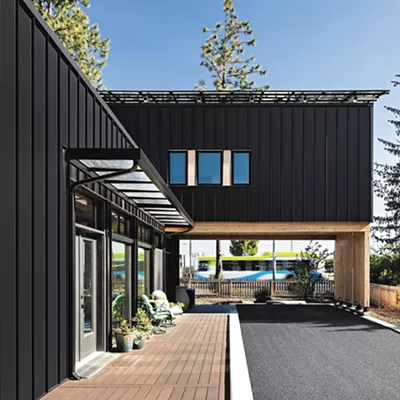
Visualize the home of the American Dream: a single-family house in a nice neighborhood, a broad expanse of green lawn, perhaps a garden, and maybe even a white picket fence. The grass in that lawn might be green in color, but chances are good that it’s far from environmentally friendly. The culturally ideal suburban lawn is an unnatural monoculture, in agricultural terms — a small-scale version of the endless corn and soybean fields of the American Midwest.
Turf grass is the nation’s No. 1 irrigated crop: About 40 million acres of land in the United States are covered in turf grass, according to a 2005 study in the Environmental Management journal, and a hefty chunk of that is in residential lawns. In 2001, Americans applied about 163 million pounds of pesticides (including herbicides) to their lawns and gardens, according to the EPA, dropping some $2.1 billion to do so. The most common home pesticide ingredients, including Roundup (glyphosate) and 2, 4-D, have been fingered as neurotoxins and hormone disrupters; many have been identified in studies as possible carcinogens; they kill beneficial insects and birds (and can sicken household pets); and their residues remain for months or even years and can migrate indoors or into drinking water supplies.
Add in countless fossil fuel-powered mowers, blowers and weed whackers, plus excessive water use, and lawn care becomes a major enemy of a nontoxic, sustainable environment.
So what’s an environmentally responsible yard-owner to do? The first step is to move away from conventional pesticides, herbicides and fertilizers and embrace less toxic or organic yard care.
“We’re hearing more and more from homeowners that if they can do [yard care] without using [pesticides and herbicides], they want to do it,” says Tom Albright of Ladybug Organic Lawn Care, one of several companies in the area focused on organic yard care. “People say, ‘I don’t want to subject our kids and our pets to the chemicals.’”
In an organic lawn — as in organic gardening — the control of pests and weeds is accomplished with the help of beneficial insects, earthworms and microbes in the soil. Healthy soil translates into healthy (and healthful) lawns and gardens.
“Most soils are so depleted in nutrients that they don’t do well,” says Albright. “Our purpose is to get the soil’s pH level back where it should be, and the nutrient levels. The idea is to rebuild the minerals, microbes and natural bacteria in the soil that are supposed to be there.”
Typical lawn problems — weeds and pests — are symptoms of larger issues, according to organic lawn-care theory: Create a healthy environment, and the lawn will thrive.
“I can usually tell what the problem is by looking,” says Albright. “If I see weeds, that means the pH is not where it should be. If I see a lot of moths, it means either the mineral levels are off or [the homeowners] are watering too much.”
In organic yard care, bugs and other crawly things are more often helpful than harmful. “A lot of bugs are beneficial,” Albright says. “They open up the top of the soil. And without ants, roses won’t open.”
Earthworms in particular are necessary to good lawn health. “Worms help get the air into the soil and get the water moving,” he says. “Any soil that’s compacted isn’t going to grow good grass.”
All plants, including grasses, need nitrogen to thrive and grow. Albright uses a compost tea to add minerals and nutrients to the soil; other sources recommend spreading organic fertilizers like compost, manure, fish emulsion, bloodmeal or cottonseed meal. One easy source of nitrogen is to leave grass clippings on the lawn after mowing. Clippings decompose quickly, turning into quick and easy lawn food.
Grass plants with deep roots resist pests and weeds better than those with shallow roots. To encourage deep roots, both the WSU Spokane County Extension Service and the Washington Department of Ecology recommend watering less frequently but for a long time, giving the lawn a good soaking but letting it dry out before watering again.
Even an organic lawn uses water and must be maintained by mowing, however. Consider that in the course of human history and culture, lawns are a relatively recent development: They arose around the same time as the Industrial Revolution, when Americans and Europeans moved in large numbers to dirty and crowded industrial centers and wanted to be reminded of a somewhat tamed version of the natural world.
Brave homeowners today may choose to resist the cultural pressures of a green grass-only carpet surrounding their homes. Such a step requires breaking out of our cultural assumptions and expectations of what’s “normal” or even beautiful.
One option is to consider a xeriscape yard. Xeriscaping describes a home landscape that uses water efficiently, relying on plants that are native to the region or will cope well with our hot dry summers and cold damp winters. From grasses like fescues and wheatgrasses to groundcovers to flowering shrubs and perennials, drought-tolerant plants can minimize the need for heavy summer watering while creating a yard that naturally resists disease and damaging insects.
The WSU Spokane County Extension Service has a xeriscape demonstration garden at its headquarters (222 N. Havana St.), and Master Gardeners will happily answer your questions by phone (477-2181) or e-mail. The Extension Website (www.spokane-county.wsu.edu) is also a great source for yard and garden tips specific to our region.
Across the country, people are tearing up all or part of their lawns to plant a garden of vegetables and flowers. In Washington, D.C., a certain family new to town made a splash by digging up part of their lawn to plant an organic garden. Replacing grass with a garden doesn’t eliminate the need for watering, but it can be done without chemicals, and it may even deliver food to the family table.
On the plus side, lawns and gardens — whether maintained organically or chemically — do act as “sinks” for carbon dioxide, absorbing the greenhouse gas from the atmosphere and turning it into food for the plants. But that small positive effect doesn’t outweigh all of the negative impacts on the environment of typical yard care methods, from pesticides, fossil fuels and excess water usage. Using nontoxic, natural or organic methods to care for your green space will help make it a space that’s “green” for your family, your neighbors and the wider community.
Five Steps to Natural Yard Care
• Build healthy soil
• Plant right for your site
• Practice smart watering
• Think twice before using pesticides
• Practice natural lawn care
Source: Washington Department of Ecology
Non-Toxic Yard Tips
• Spray weeds with white vinegar rather than a commercial herbicide.
• Use a push mower or an electric mower rather than a gasoline-powered lawnmower.
• Mow high (especially during high heat) to reduce the stress on the grass plants.
• Leave clippings on the lawn. They’ll decompose fast and add nitrogen to the soil.
• Water less often but more deeply to encourage deeper root growth.
• Use organic fertilizers (with fish emulsion, bloodmeal, cottonseed meal, compost and dried or composted manure from cows, horses or poultry) to grow lawns more slowly but stronger than those treated with chemical fertilizers.
• Aerate the soil once a year, in spring. Leave the plugs on the lawn; they will return nitrogen to the soil, feeding the grass.
• Make friends with earthworms. They eat grass clippings, aerate the soil and their castings are free food.














